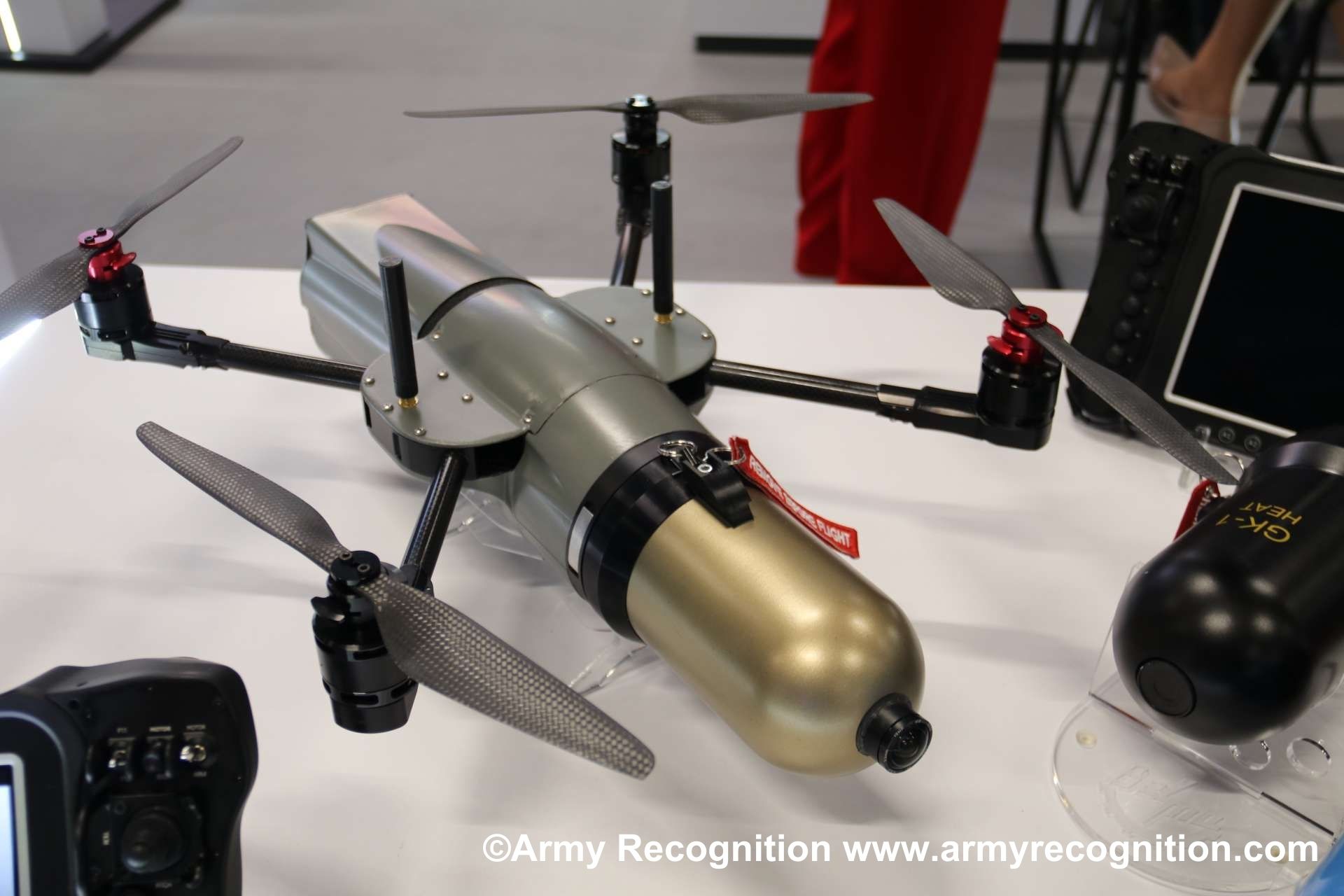Dragonfly new national made bombing UAV presented at MSPO24

{loadposition bannertop}
{loadposition sidebarpub}
The DragonFly is a new loitering munition system designed to meet the growing needs of modern armies on contemporary battlefields. Developed for combat operations in both open and urbanized environments, this versatile military drone stands out for its vertical takeoff and landing capability thanks to a quadcopter configuration. It positions itself as a major asset for armed forces seeking to maximize precision and efficiency in various contexts.Follow Army Recognition on Google News at this link
Dragon Fly presented by WITU in Poland during MSPO24 exhibition (Picture source: Army Recognition)
This system proves to be particularly flexible in accomplishing a range of missions. The DragonFly is primarily a carrier of military warheads, capable of carrying different types of warheads based on operational needs. Depending on the type of warhead used, it can be deployed to precisely target lightly armored objects or concentrated firing positions within a range of 10 km. Among the available warheads, operators have access to fragmentation, cumulative, thermobaric, or training warheads, offering great flexibility to adapt missions according to the terrain’s requirements.
Moreover, the targeting capabilities of the DragonFly are enhanced by the integration of a day or infrared camera, allowing for use both during the day and at night. This functionality broadens its operational spectrum and makes it an effective tool for continuous missions, regardless of visibility conditions.
Safety and autonomy are priorities in the design of this drone. The DragonFly is equipped with an advanced three-step safety system that allows for the remote arming and disarming of the warhead. Once the target is identified and video-tracking mode is activated, the “suicide” mission can be continued even if communication with the operator is lost, ensuring seamless continuity of the operation.
The DragonFly features remarkable technical specifications despite its compact format. With a rotor span of 700 mm and a total length of 900 mm when equipped with a warhead, it weighs only 5 kg, allowing a single soldier to handle it easily. Its operational range of 10 km and ceiling of 500 meters offer a wide range of mission options, with a maximum speed of 120 km/h. It has a hovering flight time of approximately 20 minutes, making it a valuable tool for quick and precise strikes.
In terms of flight modes, the DragonFly is designed to adapt to various combat environments. It can maintain a position in flight through an altitude hold mode without GPS or with GPS, and it can perform patrol missions, both with and without GPS. Additionally, it offers the ability to fly in attack mode, whether with or without GPS, and includes a return-to-launch function. This system is also designed to operate within a wide temperature range, from -10°C to 40°C, ensuring optimal performance in various climatic conditions, even extreme ones.

{loadposition bannertop}
{loadposition sidebarpub}
The DragonFly is a new loitering munition system designed to meet the growing needs of modern armies on contemporary battlefields. Developed for combat operations in both open and urbanized environments, this versatile military drone stands out for its vertical takeoff and landing capability thanks to a quadcopter configuration. It positions itself as a major asset for armed forces seeking to maximize precision and efficiency in various contexts.
Follow Army Recognition on Google News at this link
Dragon Fly presented by WITU in Poland during MSPO24 exhibition (Picture source: Army Recognition)
This system proves to be particularly flexible in accomplishing a range of missions. The DragonFly is primarily a carrier of military warheads, capable of carrying different types of warheads based on operational needs. Depending on the type of warhead used, it can be deployed to precisely target lightly armored objects or concentrated firing positions within a range of 10 km. Among the available warheads, operators have access to fragmentation, cumulative, thermobaric, or training warheads, offering great flexibility to adapt missions according to the terrain’s requirements.
Moreover, the targeting capabilities of the DragonFly are enhanced by the integration of a day or infrared camera, allowing for use both during the day and at night. This functionality broadens its operational spectrum and makes it an effective tool for continuous missions, regardless of visibility conditions.
Safety and autonomy are priorities in the design of this drone. The DragonFly is equipped with an advanced three-step safety system that allows for the remote arming and disarming of the warhead. Once the target is identified and video-tracking mode is activated, the “suicide” mission can be continued even if communication with the operator is lost, ensuring seamless continuity of the operation.
The DragonFly features remarkable technical specifications despite its compact format. With a rotor span of 700 mm and a total length of 900 mm when equipped with a warhead, it weighs only 5 kg, allowing a single soldier to handle it easily. Its operational range of 10 km and ceiling of 500 meters offer a wide range of mission options, with a maximum speed of 120 km/h. It has a hovering flight time of approximately 20 minutes, making it a valuable tool for quick and precise strikes.
In terms of flight modes, the DragonFly is designed to adapt to various combat environments. It can maintain a position in flight through an altitude hold mode without GPS or with GPS, and it can perform patrol missions, both with and without GPS. Additionally, it offers the ability to fly in attack mode, whether with or without GPS, and includes a return-to-launch function. This system is also designed to operate within a wide temperature range, from -10°C to 40°C, ensuring optimal performance in various climatic conditions, even extreme ones.




